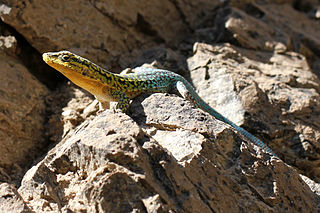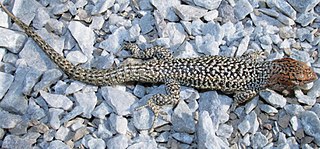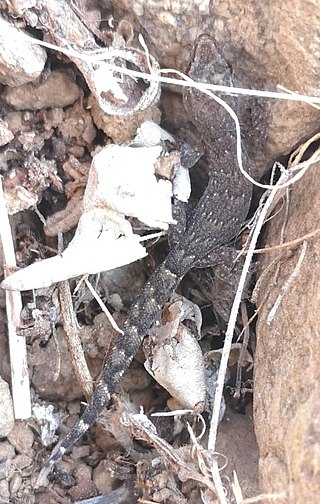
Homonota is a genus of South American geckos, commonly known as marked geckos.

Diplolaemus is a genus of lizards in the family Leiosauridae. The genus is endemic to southern South America.

Liolaemus is a genus of iguanian lizards, containing many species, all of which are endemic to South America.

Phymaturus is a genus of iguanian lizards of the family Liolaemidae, a family which was traditionally included in the Iguanidae as a subfamily, but more recently was proposed to warrant family status in the Liolaemidae. Phymaturus is the mid-sized genus of its family, with 50 species altogether known as of 2021; new species are still being discovered, however.

Tropidurus is a genus of reptiles. The genus includes many species of Neotropical ground lizards. Tropidurus is the type genus of the family Tropiduridae.

Alsodes is a genus of alsodid frogs found in Chile and Argentina. It is the most species-rich frog genus in Patagonia. Common name spiny-chest frogs has been coined for them.
Atelognathus is a genus of frogs in the family Batrachylidae. Sometimes known as Patagonia frogs, these frogs are endemic to Patagonia.

Pleurodema is a genus of leptodactylid frogs from South America. They are sometimes known under the common name four-eyed frogs, although this name can also refer to a particular species, Pleurodema bibroni. The common name is a reference to two inguinal poison glands that resemble eyes. When threatened, the frog lowers its head and raises its rear. When the frog adopts this posture, the poison glands are also raised toward the predator. The predator may also confuse the frog's raised posterior for the head of a larger animal.

Liolaemus constanzae, commonly known as Constanza's tree iguana, is a species of lizard in the family Liolaemidae. The species is endemic to South America.
Liolaemus gravenhorstii, commonly known as Gravenhorst's tree iguana, is a species of lizard in the family Liolaemidae. The species is endemic to South America.
Liolaemus paulinae is a species of lizard in the family Liolaemidae.

Octodontidae is a family of rodents, restricted to southwestern South America. Fourteen species of octodontid are recognised, arranged in seven genera. The best known species is the common degu, Octodon degus.

Garthia is a genus of lizards, commonly known as marked geckos, in the family Phyllodactylidae. The genus is endemic to South America.

Roberto Donoso-Barros was a Chilean zoologist, naturalist, and herpetologist.

Liolaemus sarmientoi is a species of lizard in the family Liolaemidae. It is considered a medium-sized example of the family, with an average snout–vent length of 76 to 77 mm, with males usually larger than females.
Pristidactylus scapulatus, Burmeister's anole, is a species of lizard in the family Leiosauridae. The species is endemic to Argentina.
Liolaemus donosobarrosi, also known commonly as Donoso-Barros' tree iguana, is a species of lizard in the family Liolaemidae. The species is endemic to Argentina.
Liolaemus gallardoi is a species of lizard in the family Liolaemidae. The species is endemic to Argentina.












